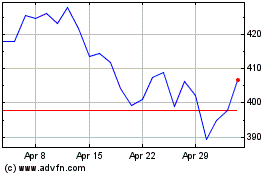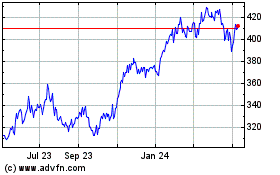By Phred Dvorak
One of the hottest topics in the tech world these days is the
race to develop and deploy artificial intelligence. U.S. companies
like Alphabet Inc. have made waves with machines that beat humans
at complex games of strategy. China has vowed to become an AI
leader by 2030 and has made huge strides in areas like facial
recognition.
Key to much of AI development is data. That's because AI has
made big leaps in recent years in machine learning, where computers
learn by picking out patterns in masses of data, and deep learning,
a technique in machine learning that is inspired by the activity of
layers of neurons in the brain.
In many of these areas of AI, the more data that is fed into the
computers, the better the results. And China, experts say, has a
lot of data -- from video captured by surveillance cameras to
information about shoppers' buying habits. Taking the lead in AI
can confer advantages in everything from the businesses that power
economic growth to the military.
So, who's ahead now, and how likely are they to stay there?
The Wall Street Journal asked two experts: Oren Etzioni, chief
executive of the Allen Institute for Artificial Intelligence in
Seattle, and Tsuhan Chen, chief scientist for AI Singapore, a
national program to foster artificial-intelligence research, and a
deputy president at the National University of Singapore. The
interviews were conducted separately and edited together.
The race to AI
WSJ: Who leads in AI now?
DR. ETZIONI: Virtually everyone agrees that the U.S. is
pre-eminent. In the commercial sector, the U.S. still clearly
dominates -- with Google and Microsoft and Amazon and others --
although the distance has been shrinking. In the academic realm, we
still lead in measures like number of papers, number of citations,
number of key leaders.
DR. CHEN: What everyone talks about as AI these days is actually
a branch of AI which we refer to as machine learning, or deep
learning. Lately, all the advances in computing -- big data, faster
computers -- make deep learning better and better.
Already, China is dominating in machine learning. They are
leveraging the availability of data. There are definitely more
people to crunch data, and there are more people providing
data.
WSJ: What are the U.S.'s strengths in AI?
DR. ETZIONI: We have this history and tradition of openness. The
U.S. is still an incredibly attractive place for a lot of people. A
huge part of developing AI is having the smartest people, the most
innovative, creative, successful.
If we succeed in keeping the United States and our university
system and our companies as a place where the best and the
brightest from all over the world want to come, then I think we're
going to substantially win the talent wars.
DR. CHEN: Being allowed to be creative is what the American
system offers.
WSJ: What about China?
DR. CHEN: The China advantage is about implementation. You don't
really need too many innovative ideas, you just need lots and lots
of computation and lots of data to get what you want.
China has a more structured government and the population all
complies. That makes AI deployment a lot easier.
If you talk about using surveillance cameras to track people, in
the U.S. that would be a lot more challenging to deploy. In China,
that would be easier.
China is more effective in deploying these systems because of
the availability of data. In the U.S., there are all these
regulations or policies guarding people in terms of privacy and
security. In China, they have data that's not protected by these
privacy or security concerns.
DR. ETZIONI: Some key variables in AI development are data,
where the Chinese have an advantage because they're less focused on
privacy, and they have more data.
A second dimension is government support. The Chinese have made
a point to have tremendous investment in AI at all levels. The U.S.
is also making substantial investment through Darpa [Defense
Advanced Research Projects Agency, the arm of the U.S. Department
of Defense that oversees research in emerging technologies],
through our venture-capital ecosystem, through the investments that
Google, Microsoft and others are making.
The weak spots
WSJ: Are there limits to China's data advantage?
DR. ETZIONI: When it comes to building the next generation of AI
systems, there are many data sets of different kinds. And, in many
of these, China does not have an advantage.
If we want to build better autonomous vehicles, we need to train
AI with pictures from the road and labels on them. I believe the
U.S. is the leader in such data sets.
In natural-language processing, there are longstanding
advantages in terms of English data sets that have been created and
curated over many years. I think we're at least equal and probably
ahead there.
Where China has more of the lead is, for example, medical data.
Here we have so many strictures around releasing that data. And
that's less of an issue in China.
You really have to go case by case and consider what's going on
there. Data is the fuel that drives this AI revolution. But it's
not like there's one kind of fuel.
Another question is: What phase in the development of AI are we
in? A tremendous amount of innovation needs to happen in order to
get from where AI is today -- which is a promising technology with
increasing applications -- to where AI can be in the future, where
the techniques can be far easier to deploy, can use far less data
and can be far more resilient to errors than they are today.
There's still huge numbers of fundamental research problems,
which is why I emphasize our university system and that whole
ecosystem as a U.S. advantage.
DR. CHEN: Machine learning benefits from more and more data. But
there are also subsets of AI that will continue to require
innovation.
One is "explainable AI." This thing called deep learning, that
benefits from more and more data, honestly we don't know why it
works. We need to know why it works, so when it fails we'll know
how to fix it. This cannot be addressed by just more data.
Another is what we refer to as "sense-making." The ultimate aim
of AI is to have computers that will make sense of everything and
do what's appropriate. That's the next level of AI, which machine
learning is not able to do yet.
This AI-powered machine that we've built -- it can drive our
cars, make investment decisions for us. But it really doesn't make
sense of things. It just picks up patterns in the data.
Take autonomous driving: How is it able to avoid people? Because
it's seen data before that says if you see people, you should steer
away. However, it's not able to infer that a person on a bicycle is
something you should also avoid.
Deep learning is recognizing patterns in data. Just because you
are able to recognize patterns in Chinese consumer data, you won't
necessarily be able to apply that to consumers in the U.S.
If 10 years from now we have machines that can make sense of
things, then whatever works well in China may also do well in the
U.S. and the rest of the world. Right now it doesn't.
China has a lot of tech companies coming to Singapore now for
exactly this reason: If you train your machines and computers using
data only in China, then it works only in China.
But in Singapore, everything is multiculture, multilanguage,
multi this, multi that. So, Singapore's advantage is that very
variety of data.
If you can make your facial-recognition system work in
Singapore, if you can make your speech recognition work in
Singapore, then it will work anywhere else in the world.
In China, facial recognition is pervasive. Yet these
facial-recognition systems that work well because of the data
there, actually do not work well anywhere else in the world.
Ms. Dvorak is a senior Asia correspondent at The Wall Street
Journal. She can be reached at phred.dvorak@wsj.com.
(END) Dow Jones Newswires
November 12, 2018 11:30 ET (16:30 GMT)
Copyright (c) 2018 Dow Jones & Company, Inc.
Microsoft (NASDAQ:MSFT)
Historical Stock Chart
From Mar 2024 to Apr 2024

Microsoft (NASDAQ:MSFT)
Historical Stock Chart
From Apr 2023 to Apr 2024
